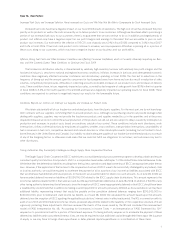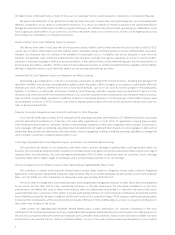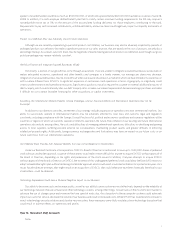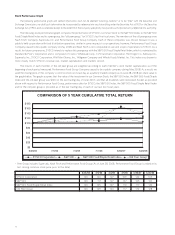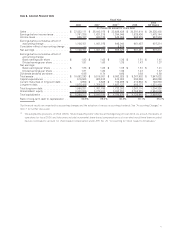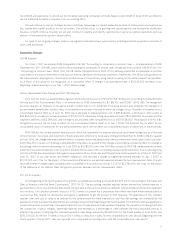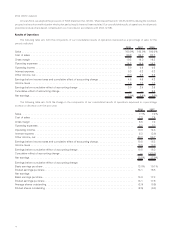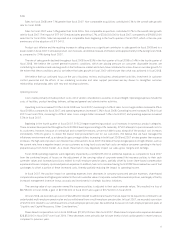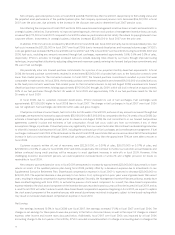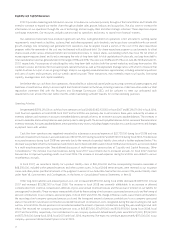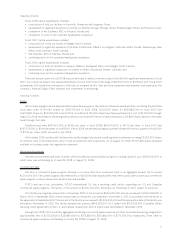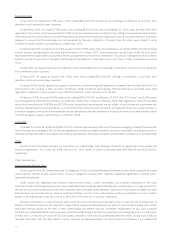Sysco 2008 Annual Report Download - page 39
Download and view the complete annual report
Please find page 39 of the 2008 Sysco annual report below. You can navigate through the pages in the report by either clicking on the pages listed below, or by using the keyword search tool below to find specific information within the annual report.Sales
Sales for fiscal 2008 were 7.1% greater than fiscal 2007. Non-comparable acquisitions contributed 0.1% to the overall sales growth
rate for fiscal 2008.
Sales for fiscal 2007 were 7.4% greater than fiscal 2006. Non-comparable acquisitions contributed 0.7% to the overall sales growth
rate for fiscal 2007.The impact of EITF 04-13 reduced sales growth by 0.7%, or $334,002,000 for fiscal 2007, compared to a $99,803,000
reduction for fiscal 2006. Sales are reported on a comparable basis beginning in the fourth quarter of fiscal 2007, which is the one-year
anniversary of the adoption of EITF 04-13.
Product cost inflation and the resulting increase in selling prices was a significant contributor to sales growth in fiscal 2008 and to a
lesser extent in fiscal 2007. Estimated product cost increases, an internal measure of inflation, were approximately 6.0% during fiscal 2008,
as compared to 3.4% during fiscal 2007.
The rate of sales growth declined throughout fiscal 2008 from 8.5% in the first quarter of fiscal 2008 to 5.4% in the fourth quarter of
fiscal 2008. We believe the current general economic conditions, which are placing pressure on consumer disposable income, are
contributing to a decline in real volume growth in the foodservice market and in turn, have contributed to a slow-down in our sales growth.To
the extent that these conditions persist, we believe that sales growth in fiscal 2009 will be lower than what was achieved in fiscal 2008.
We believe that our continued focus on the use of business reviews and business development activities, investment in customer
contact personnel and the efforts of our marketing associates and sales support personnel are key drivers to strengthen customer
relationships and growing sales with new and existing customers.
Operating Income
Cost of sales primarily includes product costs, net of vendor consideration, as well as in-bound freight. Operating expenses include the
costs of facilities, product handling, delivery, selling and general and administrative activities.
Operating income increased 10.0% in fiscal 2008 over fiscal 2007, increasing to 5.0% of sales. Gross margin dollars increased 6.5% in
fiscal 2008 as compared to fiscal 2007, and operating expenses increased 5.3% in fiscal 2008. Operating income increased 14.3% in fiscal
2007 over fiscal 2006, increasing to 4.9% of sales. Gross margin dollars increased 7.4% in fiscal 2007, and operating expenses increased
5.3% in fiscal 2007.
Beginning in the fourth quarter of fiscal 2007, SYSCO began experiencing product cost increases in numerous product categories.
These increases have persisted throughout fiscal 2008 at levels approximating 6.0%. Generally, SYSCO attempts to pass increased costs to
its customers; however, because of contractual and competitive reasons, we are not able to pass along all of the product cost increases
immediately. SYSCO’s goal is to obtain the lowest total procurement cost for our customers. We believe that we have managed the
inflationary environment well, as evidenced by gross margin dollars increasing in both fiscal 2008 and 2007 at rates greater than expense
increases. The high rate of product cost inflation has continued into fiscal 2009. We believe that prolonged periods of high inflation, such as
the current rate, have a negative impact on our customers as rising food costs and fuel costs can reduce consumer spending in the food-
prepared-away-from home market. As a result, these factors may negatively impact our sales, gross margins and earnings.
Fiscal 2008 operating expenses were negatively impacted by a net $24,135,000 in additional expenses as compared to fiscal 2007
from the combined impact of losses on the adjustment of the carrying value of corporate-owned life insurance policies to their cash
surrender values and increased provisions related to multi-employer pension plans, partially offset by lower share-based compensation
expense and lower company-sponsored pension expenses. In addition, fuel costs increased during fiscal 2008. We increased our use of fuel
surcharges to offset a portion of these increased costs, thereby partially reducing the impact to operating income.
In fiscal 2007, the positive impact on operating expenses from decreases in company-sponsored pension expenses, share-based
compensation expenses and higher gains related to the cash surrender value of corporate-owned life insurance policies, was largely offset by
increased management incentive bonus accruals and investments in strategic business initiatives.
The carrying value of our corporate-owned life insurance policies is adjusted to their cash surrender values. This resulted in a loss of
$8,718,000 in fiscal 2008, a gain of $23,922,000 in fiscal 2007 and a gain of $9,702,000 in fiscal 2006.
In fiscal 2008, we recorded a provision of $22,284,000 related to additional amounts that we expect to be required to contribute to an
underfunded multi-employer pension plan and our withdrawal from a multi-employer pension plan. In fiscal 2007, we recorded a provision
of $4,700,000 related to our withdrawal from a multi-employer pension plan. See additional discussion of multi-employer pension plans at
“Liquidity and Capital Resources, Other Considerations.”
Share-based compensation cost in fiscal 2008 was $17,335,000 less than fiscal 2007. Share-based compensation expense decreased
$28,852,000 in fiscal 2007 over fiscal 2006. These decreases were primarily due to lower levels of stock option grants in recent years as
compared to previous years.
15


